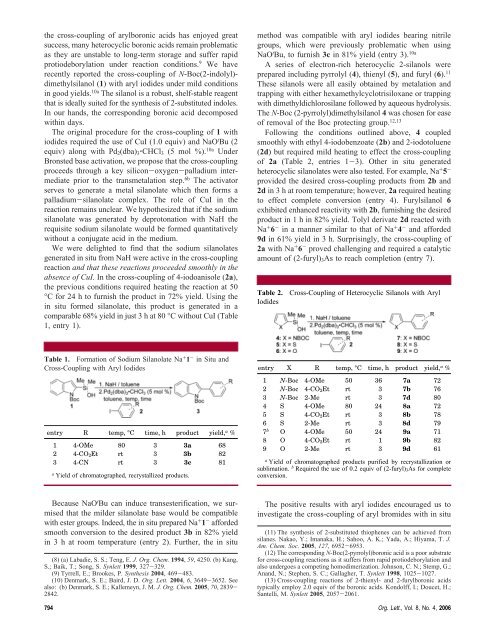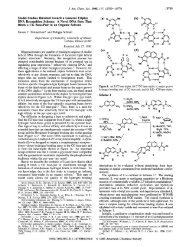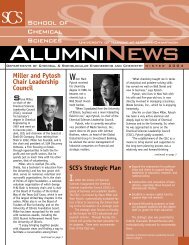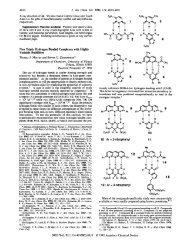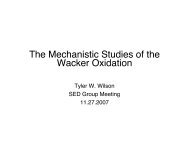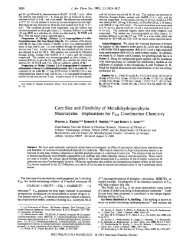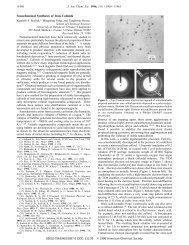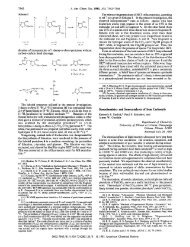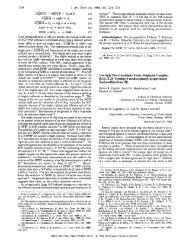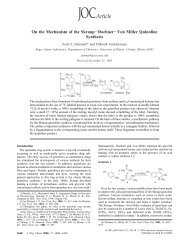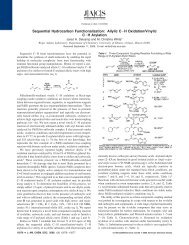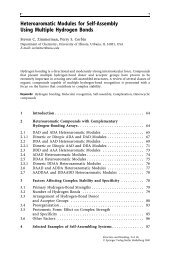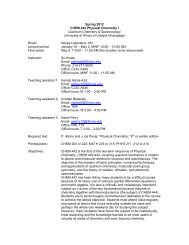Palladium-Catalyzed Cross-Coupling Reactions of Heterocyclic ...
Palladium-Catalyzed Cross-Coupling Reactions of Heterocyclic ...
Palladium-Catalyzed Cross-Coupling Reactions of Heterocyclic ...
You also want an ePaper? Increase the reach of your titles
YUMPU automatically turns print PDFs into web optimized ePapers that Google loves.
the cross-coupling <strong>of</strong> arylboronic acids has enjoyed great<br />
success, many heterocyclic boronic acids remain problematic<br />
as they are unstable to long-term storage and suffer rapid<br />
protiodeborylation under reaction conditions. 9 We have<br />
recently reported the cross-coupling <strong>of</strong> N-Boc(2-indolyl)-<br />
dimethylsilanol (1) with aryl iodides under mild conditions<br />
in good yields. 10a The silanol is a robust, shelf-stable reagent<br />
that is ideally suited for the synthesis <strong>of</strong> 2-substituted indoles.<br />
In our hands, the corresponding boronic acid decomposed<br />
within days.<br />
The original procedure for the cross-coupling <strong>of</strong> 1 with<br />
iodides required the use <strong>of</strong> CuI (1.0 equiv) and NaO t Bu (2<br />
equiv) along with Pd 2 (dba) 3 ‚CHCl 3 (5 mol %). 10a Under<br />
Bronsted base activation, we propose that the cross-coupling<br />
proceeds through a key silicon-oxygen-palladium intermediate<br />
prior to the transmetalation step. 6b The activator<br />
serves to generate a metal silanolate which then forms a<br />
palladium-silanolate complex. The role <strong>of</strong> CuI in the<br />
reaction remains unclear. We hypothesized that if the sodium<br />
silanolate was generated by deprotonation with NaH the<br />
requisite sodium silanolate would be formed quantitatively<br />
without a conjugate acid in the medium.<br />
We were delighted to find that the sodium silanolates<br />
generated in situ from NaH were active in the cross-coupling<br />
reaction and that these reactions proceeded smoothly in the<br />
absence <strong>of</strong> CuI. In the cross-coupling <strong>of</strong> 4-iodoanisole (2a),<br />
the previous conditions required heating the reaction at 50<br />
°C for 24 h to furnish the product in 72% yield. Using the<br />
in situ formed silanolate, this product is generated in a<br />
comparable 68% yield in just3hat80°C without CuI (Table<br />
1, entry 1).<br />
method was compatible with aryl iodides bearing nitrile<br />
groups, which were previously problematic when using<br />
NaO t Bu, to furnish 3c in 81% yield (entry 3). 10a<br />
A series <strong>of</strong> electron-rich heterocyclic 2-silanols were<br />
prepared including pyrrolyl (4), thienyl (5), and furyl (6). 11<br />
These silanols were all easily obtained by metalation and<br />
trapping with either hexamethylcyclotrisiloxane or trapping<br />
with dimethyldichlorosilane followed by aqueous hydrolysis.<br />
The N-Boc (2-pyrrolyl)dimethylsilanol 4 was chosen for ease<br />
<strong>of</strong> removal <strong>of</strong> the Boc protecting group. 12,13<br />
Following the conditions outlined above, 4 coupled<br />
smoothly with ethyl 4-iodobenzoate (2b) and 2-iodotoluene<br />
(2d) but required mild heating to effect the cross-coupling<br />
<strong>of</strong> 2a (Table 2, entries 1-3). Other in situ generated<br />
heterocyclic silanolates were also tested. For example, Na + 5 -<br />
provided the desired cross-coupling products from 2b and<br />
2d in3hatroom temperature; however, 2a required heating<br />
to effect complete conversion (entry 4). Furylsilanol 6<br />
exhibited enhanced reactivity with 2b, furnishing the desired<br />
product in 1hin82%yield. Tolyl derivate 2d reacted with<br />
Na + 6 - in a manner similar to that <strong>of</strong> Na + 4 - and afforded<br />
9d in 61% yield in 3 h. Surprisingly, the cross-coupling <strong>of</strong><br />
2a with Na + 6 - proved challenging and required a catalytic<br />
amount <strong>of</strong> (2-furyl) 3 As to reach completion (entry 7).<br />
Table 2.<br />
Iodides<br />
<strong>Cross</strong>-<strong>Coupling</strong> <strong>of</strong> <strong>Heterocyclic</strong> Silanols with Aryl<br />
Table 1. Formation <strong>of</strong> Sodium Silanolate Na + 1 - in Situ and<br />
<strong>Cross</strong>-<strong>Coupling</strong> with Aryl Iodides<br />
entry R temp, °C time, h product yield, a %<br />
1 4-OMe 80 3 3a 68<br />
2 4-CO 2Et rt 3 3b 82<br />
3 4-CN rt 3 3c 81<br />
a Yield <strong>of</strong> chromatographed, recrystallized products.<br />
entry X R temp, °C time, h product yield, a %<br />
1 N-Boc 4-OMe 50 36 7a 72<br />
2 N-Boc 4-CO 2Et rt 3 7b 76<br />
3 N-Boc 2-Me rt 3 7d 80<br />
4 S 4-OMe 80 24 8a 72<br />
5 S 4-CO 2Et rt 3 8b 78<br />
6 S 2-Me rt 3 8d 79<br />
7 b O 4-OMe 50 24 9a 71<br />
8 O 4-CO 2Et rt 1 9b 82<br />
9 O 2-Me rt 3 9d 61<br />
a Yield <strong>of</strong> chromatographed products purified by recrystallization or<br />
sublimation. b Required the use <strong>of</strong> 0.2 equiv <strong>of</strong> (2-furyl) 3As for complete<br />
conversion.<br />
Because NaO t Bu can induce transesterification, we surmised<br />
that the milder silanolate base would be compatible<br />
with ester groups. Indeed, the in situ prepared Na + 1 - afforded<br />
smooth conversion to the desired product 3b in 82% yield<br />
in3hatroom temperature (entry 2). Further, the in situ<br />
(8) (a) Labadie, S. S.; Teng, E. J. Org. Chem. 1994, 59, 4250. (b) Kang,<br />
S.; Baik, T.; Song, S. Synlett 1999, 327-329.<br />
(9) Tyrrell, E.; Brookes, P. Synthesis 2004, 469-483.<br />
(10) Denmark, S. E.; Baird, J. D. Org. Lett. 2004, 6, 3649-3652. See<br />
also: (b) Denmark, S. E.; Kallemeyn, J. M. J. Org. Chem. 2005, 70, 2839-<br />
2842.<br />
The positive results with aryl iodides encouraged us to<br />
investigate the cross-coupling <strong>of</strong> aryl bromides with in situ<br />
(11) The synthesis <strong>of</strong> 2-substituted thiophenes can be achieved from<br />
silanes. Nakao, Y.; Imanaka, H.; Sahoo, A. K.; Yada, A.; Hiyama, T. J.<br />
Am. Chem. Soc. 2005, 127, 6952-6953.<br />
(12) The corresponding N-Boc(2-pyrrolyl)boronic acid is a poor substrate<br />
for cross-coupling reactions as it suffers from rapid protiodeborylation and<br />
also undergoes a competing homodimerization. Johnson, C. N.; Stemp, G.;<br />
Anand, N.; Stephen, S. C.; Gallagher, T. Synlett 1998, 1025-1027.<br />
(13) <strong>Cross</strong>-coupling reactions <strong>of</strong> 2-thienyl- and 2-furylboronic acids<br />
typically employ 2.0 equiv <strong>of</strong> the boronic acids. Kondolff, I.; Doucet, H.;<br />
Santelli, M. Synlett 2005, 2057-2061.<br />
794 Org. Lett., Vol. 8, No. 4, 2006


